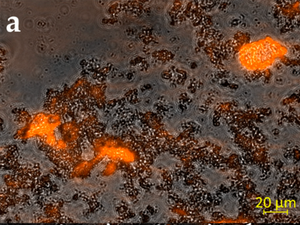
Sterilisation of root canals before filling is crucial, as unsterile root canals can lead to microbial regrowth and infection. Using methods available today, bacterial regrowth cannot always be prevented as root canal cleaning is challenging mostly due to limited access and the porous structure of dentin. A study by Koch & Palarie et al. published in the journal Microorganisms presents an electrochemical disinfection method using boron-doped diamond electrodes and saline solution to generate disinfectant radicals in situ. A canine tooth model was used to compare electrochemical cleaning with extended saline irrigation in its effectiveness to eliminate E. faecalis. By comparing CFU counts before and after cleaning, the researchers showed that 0.5 min of electrochemical cleaning was as effective as 7.5 min of saline irrigation. To investigate multispecies biofilm formation, human teeth were incubated with a mixture of microorganisms isolated from root canal instruments and incubated at 37 °C. Biofilms, isolated with toothpicks or formed on tooth segments were stained using EbbaBiolight 680 at day 5 and 7 of incubation. Imaging shows formation of extracellular matrix components reported by EbbaBiolight fluorescence.
Image: Mixed species biofilm treated with EbbaBiolight 680 and imaged using confocal microscopy. EbbaBiolight 680 stains the extracellular matrix (orange) and bacterial cells are outlined by the overlaid brightfield image (grey).Image from Figure 4A by Koch et al. (2022) Microorganisms, 10(4), 782 (CC BY 4.0)
To benchmark conventional irrigation using 0.9% saline with 0.2% chlorhexidine and electrochemical disinfection with different electrodes, prepared teeth were incubated with isolates from root canal treatments at 37 °C for three days to induce multispecies biofilm formation. Treated teeth were split longitudinally and bacteria content was assessed qualitatively by pressing onto blood agar plates and quantitatively by sampling and consecutive incubation in brain heart infusion broth. Electrochemical treatment with Boron-Doped Diamond electrodes at 6.5 V was the most effective treatment, but still not able to eradicate all bacteria. Three gram-positive species (Bacillus subtilis, Staphylococcus epidermidis, and Staphylococcus xylosus) were found to be resistant to the treatment. When the method was tested on a canine tooth model, there was a massive reduction of bacterial growth after irrigation with chlorhexidine and additional application of electrochemical treatment led to a further reduction in bacterial load, but not complete sterilisation of the root canal. Taken together, the study by Koch et al. showcases the difficulty of managing in situ biofilm growth, especially for highly technical root canal treatments and highlights a protective role of biofilm extracellular matrix facilitating bacterial regrowth after treatment.
